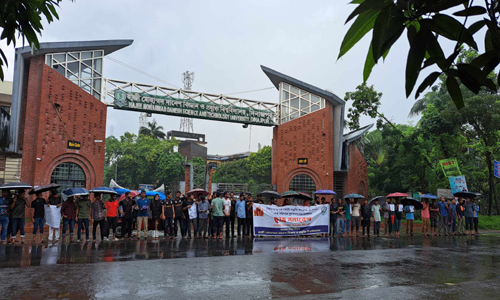Following the lead of public universities across the country, the general students of Hajee Mohammad Danesh Science and Technology University (HSTU) in Dinajpur have staged a sit-in protest demanding the reform of the quota system in government jobs and the reinstatement of the 2018 circular.
The sit-in protest took place at the main gate of the university on Friday (July 5) at 3 PM. As the protest began, groups of students started gathering in front of the main gate. Traffic on the highway adjacent to the university remained normal during this time.
At the student gathering, HSTU’s general students demanded the reform of the quota system through various slogans such as “No place for discrimination in Golden Bengal,” “We have only one demand, reform the quota system,” and “Quota or merit? Merit, merit.”
The protesting students stated that they had gathered today to demand the reinstatement of the 2018 circular that abolished the quota system. They have four demands. The first demand is to maintain the 2018 circular abolishing the quota system in government jobs and to ensure merit-based recruitment.
The second demand is to form a commission to abolish all irrational and discriminatory quotas in all grades of government jobs. The third demand is that quota benefits cannot be used multiple times in government job recruitment exams, and vacancies in quotas should be filled based on merit. The final demand is to take effective measures to ensure a corruption-free, impartial, and merit-based bureaucracy.
After the sit-in, the general students announced a nationwide sit-in program at public universities across the country. The general students faced no obstruction during their sit-in protest and completed their program peacefully.
It is worth mentioning that until 2018, 56 percent of government jobs in Bangladesh were reserved under various quotas. This included a 30 percent quota for freedom fighters, 10 percent for women, 10 percent for residents of underprivileged districts, 5 percent for ethnic minorities, and 1 percent for people with disabilities.
That year, there were major protests in various educational institutions, including Dhaka University, demanding the reform of the quota system, reducing it from 56 percent to 10 percent. Later, on October 4 of that year, the Ministry of Public Administration issued a circular abolishing the quota system.
